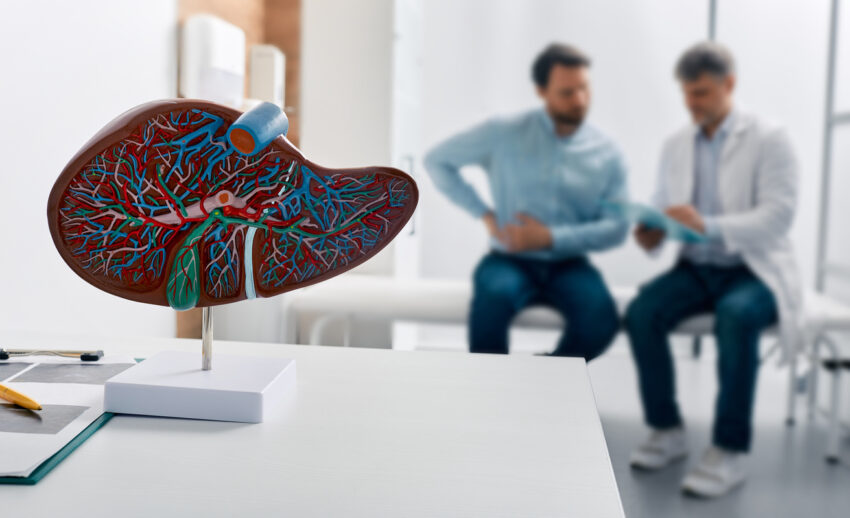
Share On Social!
We know many types of cancer deeply and disproportionately affect U.S. Latinos.
Liver cancer is a particular problem.
In fact, Latinos have the second-highest rate of dying from liver cancer among racial/ethnic groups, according to the CDC.
Let’s examine the data and unpack this rising crisis for Latinos.
What is Liver Cancer?
The liver has many important jobs in the body. It plays a role in digestion, supporting healthy blood flow, breaking down needed nutrients, and more.
Liver cancer can start at any part of the liver. The most common type of liver cancer is hepatocellular carcinoma (HCC).
“Liver cancer is a disease in which malignant (cancer) cells form in the tissues of the liver. The liver is one of the largest organs in the body. It has 2 lobes and fills the upper right side of the abdomen inside the rib cage,” according to Understand Cancer Together.
In 2022, an estimated 41,000 people were diagnosed with liver cancer in the United States.
“Rates of liver cancer are going up in the United States. In men, HCC ranks as the fifth most common cause of cancer-related death. For women, it ranks seventh,” according to Healthline.
Cirrhosis, severe scarring of the liver, is a major risk factor for developing liver cancer. About 80% of people diagnosed with liver cancer have cirrhosis.
Healthline highlighted risk factors for both cirrhosis and liver cancer such as:
- Hepatitis B or C infection
- High alcohol intake
- Exposure to aflatoxin from contaminated food, water or soil
- Smoking tobacco
- Nonalcoholic steatohepatitis (NASH)
Although there are no standard or routine screening tests for liver cancer, some tests are being used or studied to screen for it and/or diagnose it.
These tests include an ultrasound, CT scan, and Alpha-fetoprotein tumor marker.
Screenings for liver cancer are currently recommended for adults with increased risk.
“Being at increased risk doesn’t mean you’ll definitely get liver cancer. But you may need to start regular screening exams. So, if you do get cancer, your doctor finds it at its earliest stage,” according to The University of Texas MD Anderson Cancer Center.
Treatment plans for liver cancer depend on several factors including:
- The size of the tumor.
- If there is cirrhosis of the liver.
- Your general health.
- The cancer stage.
“Treatments that aim to cure liver cancer are usually only used for early-stage cancers. If the tumor is found at a later stage, treatment other than surgery may be used. Your team will determine the most appropriate therapy for you,” according to The University of Texas MD Anderson Cancer Center.
How Does Liver Cancer Impact Latinos?
Latinos have a higher risk of developing liver cancer.

In fact, Latinos suffer two times higher rates of liver cancer—an infection-related but preventable cancer—than their white peers, according to a study from the American Cancer Society.
Overall, 1 in 5 people with liver cancer in the United States are Latino, with an 4.7% increase since 2000, according to 2018 data.
“In 2021, approximately 7,100 Hispanic individuals will be diagnosed with [liver cancer], with more than two-thirds of cases occurring in men. About 4,100 liver cancer deaths are expected to occur among Hispanic men and women in 2021,” according to the most recent Cancer Facts & Figures for Hispanic/Latino People 2021-2023 report from the American Cancer Society.
In addition, Latinos are often diagnosed at more advanced stages of liver cancer.
“This means there are often fewer treatment options available,” according to Healthline.
Why Do Latinos Suffer So Much from Liver Cancer?
The disparity in liver among Latinos happens for many reasons.
Most liver cancer cases result from excess body weight, heavy alcohol use, smoking, and metabolic disorders.
“Hispanic men and women have a higher prevalence of type 2 diabetes and excess body weight compared to non-Hispanic Whites and thus are likely to have a disproportionate burden of metabolic-associated liver cancer in the future,” according to Cancer Facts & Figures for Hispanic/Latino People 2021-2023.
Other risk factors include:
- Aflatoxin exposure
- Chronic HBV
- Chronic HCV
- Cirrhosis
- Nonalcoholic fatty liver disease (NAFLD) and non-alcoholic steatohepatitis (NASH)
- Socioeconomic status
- Lack of health insurance / screening
- Language barriers
- Lack of access to culturally appropriate care
Exposure to aflatoxins – cancer-causing chemicals produced by mold that can contaminate improperly stored foods – is also linked to liver cancer in Latinos.
Liver cancer cases had six-times-higher odds of having detectable levels of aflatoxins in their blood, compared to non-cases, in a 2017 study of Latinos.
“This study means that Latinos have unique exposures that put them at higher risk for liver cancer,” said Dr. Amelie G. Ramirez, leader of Salud America! at UT Health San Antonio.
Eliminating Liver Cancer Disparities
How can liver cancer issues get addressed?
It is important for the healthcare system and health organizations to consider the diversity in Latino cultures and how culturally appropriate care can improve screening and preventive care, helping reduce risk factors associated with cirrhosis and liver cancer.
“To help reduce health disparities, the public health community can work to improve health literacy, address barriers to care, and provide language assistance to people who need it,” according to the CDC.
Representation in healthcare is important.
Therefore, the need to support Latino students and those looking to have careers in the medical field is crucial.
“Getting care from someone who speaks your language and understands your culture can make a big difference,” according to Healthline.
What Can You Do to Address Latino Liver Cancer?
You can join a clinical trial!
Clinical trials are studies with volunteers that help researchers learn how to slow, manage, and treat cancer and other diseases.
But only a very small percentage participate in clinical trials.
“This massive underrepresentation of Latinos in clinical trials makes it hard for researchers to develop new treatments for this group, which suffers a heavy burden of cancer, Alzheimer’s, and other diseases,” said Dr. Ramirez.
Dr. Ramirez is creating new ways to encourage Latinos to volunteer for cancer and Alzheimer’s clinical trials, with support from Genentech, a member of the Roche Group.
She is raising awareness by using Salud America! to showcase open clinical trials and uplift the stories of Latino clinical trial participants along with social media events and webinars.
“Latinos in clinical trials are not only helping themselves, but they are also building a future with better treatments that can help their families and communities,” Dr. Ramirez said.
Editor’s Note: This article is part of a collaboration between Salud America! at the Institute for Health Promotion Research at UT Health San Antonio and Bristol Myers Squibb to focus on improving liver health. To find additional content, go here.
By The Numbers
142
Percent
Expected rise in Latino cancer cases in coming years



